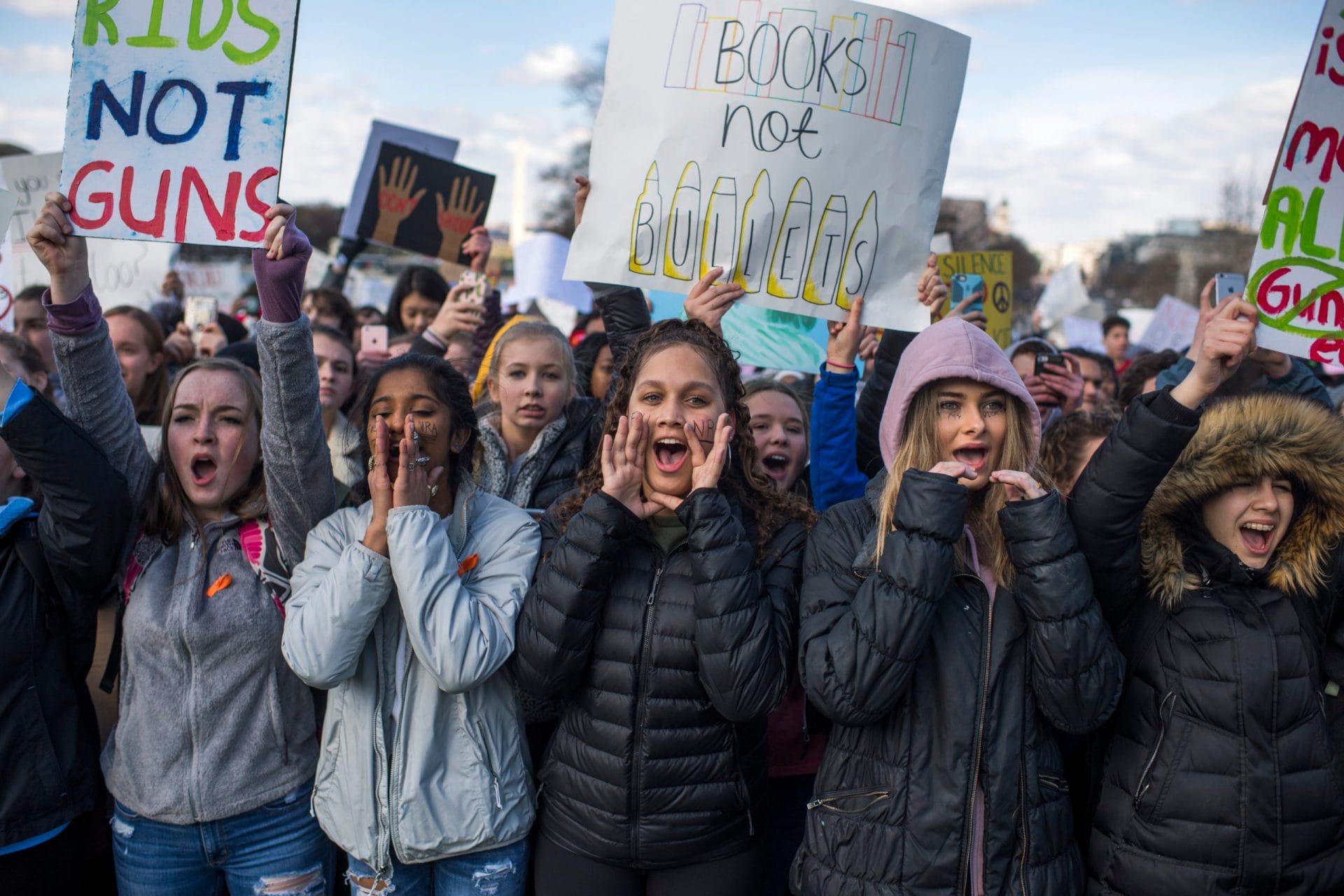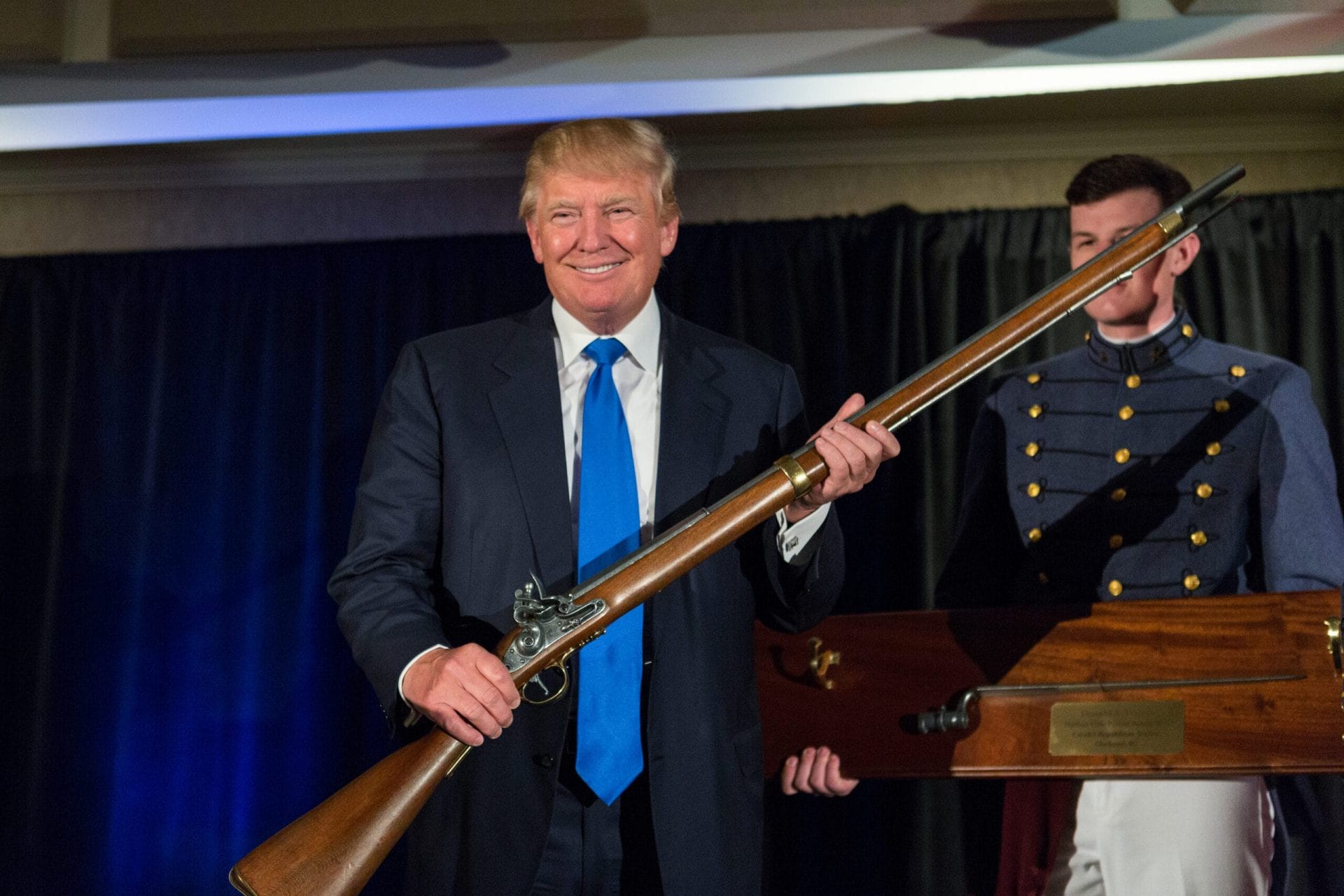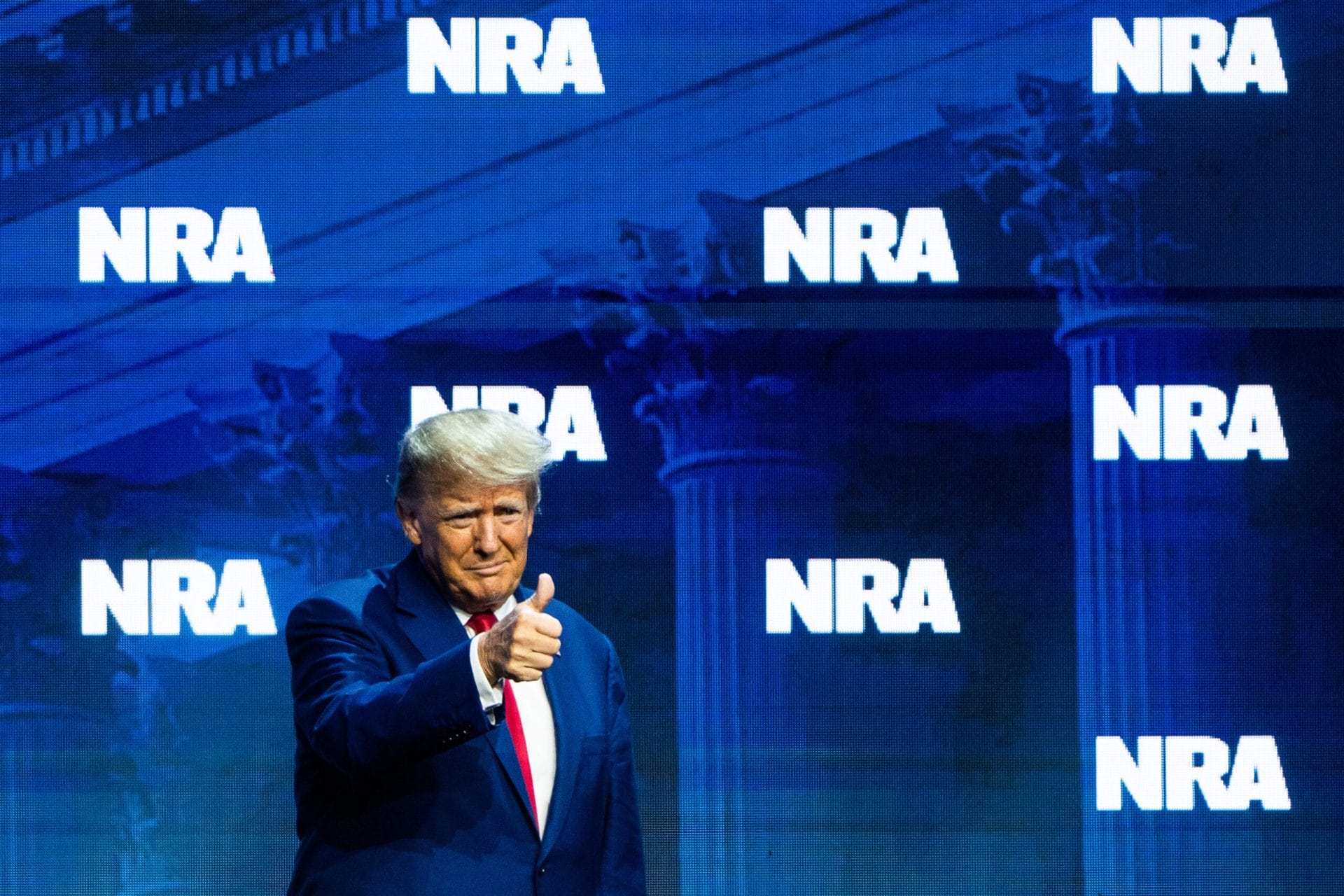
Tracking Trump’s Disastrous Record on Guns
Trump is six months into his second term in the White House. So what’s he been doing about gun violence?
Donald Trump has said quite a bit on the issue of gun violence since his ride down the escalator in 2015.
Which makes sense—he was president during some of the worst mass shootings in American history, while gun homicides skyrocketed, and when guns became the number one killer of children.
During his first term, Trump alternated paying lip service to popular gun safety policies with NRA talking points. But actions speak louder than words, and Trump’s actions on guns as president consisted mainly of placating the gun lobby and making America less safe. Much of his record on guns got buried under other news—so we’re here to remind everyone exactly what he did during his first term as president.
We’ll also be tracking what Trump does—and doesn’t do—during the next four years. After all, before he was inaugurated he bragged about doing nothing on guns, told the NRA that “no one will lay a finger on your firearms,” and promised to roll back Biden-era gun safety measures. GIFFORDS is going to be fighting back each and every step of the way—and we’ll keep this page updated as his second term unfolds.
Trump reassigned federal agents, taking them away from their jobs fighting crime.
About 3,000 FBI agents have been reassigned from their duties related to cybercrimes, drug trafficking, terrorism, counterintelligence, and more to immigration enforcement—nearly a quarter of the FBI’s total agents across the country. The data, obtained by Senator Mark Warner of Virginia, only represents the number of agents working on immigration at least 50% of their time; the amount of FBI resources devoted to immigration is likely much higher.
These reassignments reflect a considerable reshaping of the FBI, which tends to focus on national security threats. According to former agents, as a result of these reassignments, agents are stretched thin and morale is low.
Similarly, CNN reports that the ATF—the primary agency in charge of enforcing our nation’s gun laws—has reassigned 80% of special agents to immigration cases. As a result, the ATF has lost one in every seven firearms license investigators, and stands to lose many more under Trump’s proposed budget. These reassignments are already shifting resources away from serious gun crimes and dangerous weapons dealers: For the first four and half months of 2025, the ATF did not revoke a single gun dealer’s license.
Trump made it harder for community-based organizations to access community violence prevention grants.
In 2022, Congress established—for the first time—a dedicated grant program within the Department of Justice specifically to support community violence intervention (CVI) efforts. The Community Violence Intervention and Prevention Initiative (CVIPI) was initially a $50 million annual investment over five years that was focused on preventing and reducing violent crime in communities by supporting comprehensive, evidence-informed community violence intervention and prevention programs through direct investment and capacity building support.
But now, Trump’s Department of Justice eliminated federal funding for CVI as we know it. In a major shift, CVIPI grants for Fiscal Year 2025 are now capped at $34.6 million and are closely tied to support for law enforcement—with no pathway for community-based organizations to be awarded funds outside of being subrecipients of government agencies, which comes with strict parameters. In fact, the new “purpose” of CVIPI is to support “law enforcement efforts to reduce violent crime and improve police-community relations through a range of cross-sector enforcement, prevention, and intervention strategies that leverage active collaboration with communities through sustained partnerships and engagement.”
Historically, public safety strategies in the US have prioritized law enforcement efforts and discounted community-led programs that have a proven track record of reducing violence. This has created a chasm between the two, both in terms of funding and in police-community trust. By now requiring these local and state programs to partner with law enforcement to access these funds, Trump has put a significant roadblock in the way of properly developing community-based organizations that desperately need access to federal funding to do the work that law enforcement cannot do to save lives.
Trump put gun industry profits above public safety yet again, weakening safeguards for gun exports to high-risk countries.
In 2024, the Biden administration imposed limits on civilian firearm exports, establishing stronger review standards and rules to reduce the risk of legally exported guns being diverted to criminals, terrorists, and drug cartels. These rules followed a report that linked legally exported US guns to higher rates of crime and violence across the world—including the massacre of schoolchildren.
Now, Trump has rescinded these restrictions under the guise of “defending” the Second Amendment.
This policy change has the potential to fuel violence across the world with US weapons, harming the US’s interests at home and abroad—all to benefit US gun manufacturers. With previously restricted markets open, the gun industry CEOs will be able to make more money than ever, all while fueling the violence this administration claims to protect us from.
Trump removed a study showing that attacks by far-right extremists “outpace” those by the left.
In September, Trump’s Department of Justice quietly removed a study from its website that indicated far-right extremists are responsible for the bulk of ideologically motivated deaths in America. Published in 2024, the study found that, “Since 1990, far-right extremists have committed far more ideologically motivated homicides than far-left or radical Islamist extremists, including 227 events that took more than 520 lives. In this same period, far-left extremists committed 42 ideologically motivated attacks that took 78 lives.” The deadliest domestic terrorism attack in American history, the 1995 bombing of a federal building in Oklahoma City, was done by a rightwing extremist who hated the federal government and, specifically, the ATF.
This removal comes on the heels of right-wing claims, including from Trump, that the “radical left” is responsible for extremism in America. In the wake of Charlie Kirk’s death, these claims have surged, despite clear evidence from a variety of recent studies that far-right extremists pose a severe threat to Americans.
Trump deployed the National Guard in DC and other American cities.
On August 11, the White House published a memo mobilizing the National Guard in Washington DC due to “rising crime,” despite the fact that violence in the city has been decreasing in recent years. Shortly after, the Secretary of Defense Pete Hegseth authorized National Guard members to be armed. Since then, residents of Washington DC have been subjected to members of the military overseeing ordinary day-to-day behavior, including taking public transportation, going to the grocery store, and walking in the park with kids—all while they hold powerful rifles.
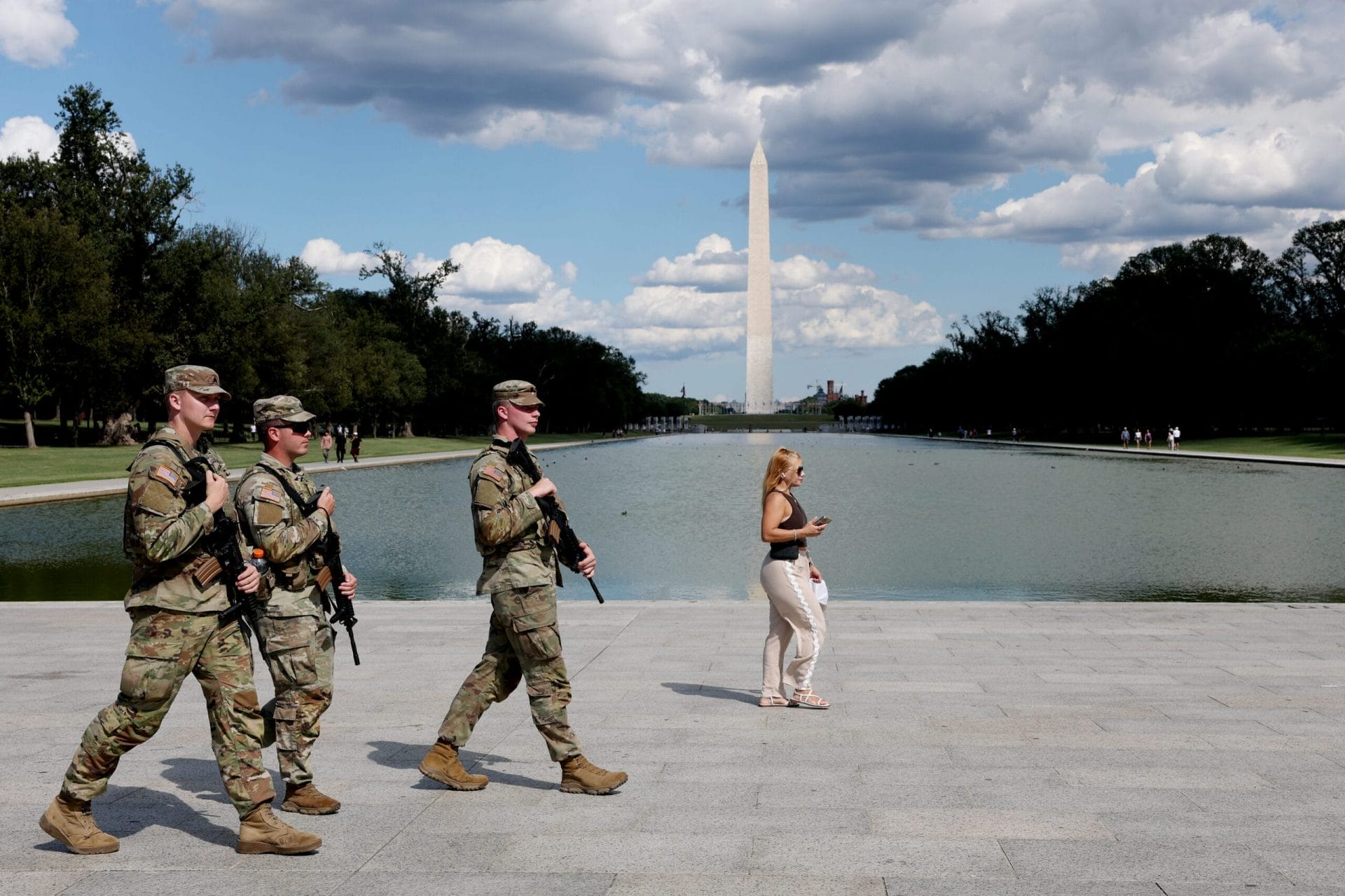
Trump’s deployment isn’t just focused on DC. Earlier this year, he deployed the National Guard in Los Angeles—in a move that a judge later determined broke the law. Since September, troops have also been sent to Memphis and were going to be sent to Chicago until a judge temporarily halted the order. Trump has said he would consider similar deployments in Portland, St. Louis, and New Orleans.
Many Americans list crime as among their top concerns, and they’re right: We must improve this nation’s public safety infrastructure. But the militarization of federal troops against the residents they’ve sworn to protect is not the solution. In fact, it has and will continue to escalate tensions between law enforcement and the public. In DC, court records indicate that federal agents are concentrating their arrests in already over-policed neighborhoods and are overwhelmingly arresting Black people, mostly for misdemeanors—putting an unnecessary strain on the court and jail systems. Not to mention that these deployments are taking away resources from actual emergencies and, according to some estimates, costing Americans $1 million every day.
Keeping communities safe and reducing crime requires investment in our communities and the ATF—not creating chaos and harassing innocent people in our cities. We must fund the law enforcement agencies responsible for stopping gun crime, implement stronger gun laws to ensure criminals can’t get their hands on them, and stop sowing distrust among community members.
Trump ended the pistol brace rule.
In 2023, the ATF published a rule clarifying whether certain products marketed as stabilizing braces were covered by the National Firearms Act. The gun lobby had been deceptively selling devices designed to convert pistols into illegal, concealable short-barreled rifles as “stabilizing braces.” The ATF rule determined that these specific devices were in fact regulated by the National Firearms Act, just like machine guns, silencers, and other exceptionally dangerous weapons.
Shortly after the ATF rule was finalized, the gun lobby filed a challenge and the case began making its way up the courts. Once power shifted hands in January 2025, Trump’s Justice Department gave in and dismissed the government’s appeal on July 17 and, effectively, completely vacating the ATF rule—meaning that devices designed to convert pistols into short-barreled rifles are now no longer treated as the exceptionally dangerous firearms they are, and not subject to universal background checks.
Trump plans to slash gun regulations at the ATF.
According to the Washington Post, the US Department of Government Efficiency (DOGE)—a new initiative under the Trump administration—has sent staff to the ATF in order to revise or eliminate at least 50 rules and gun restrictions.
The ATF has been the target of the Trump administration since it took over in January (read below for more information). But this may be the first substantial step in its planned assault on law enforcement. DOGE plans to slash the agency’s budget, gut the number of gun dealer inspectors, and reduce its ability to do its job: fight violent crime and enforce federal gun laws.
This follows a push by Republicans in Congress to eliminate the agency completely, as well as a proposal from Attorney General Pam Bondi to fold the ATF into the Drug Enforcement Administration (DEA)—a move that would decimate federal enforcement of gun laws.
Trump effectively legalized machine guns.
On May 16, the Trump administration agreed to a settlement that requires the Department of Justice to “not enforce the machine gun ban against any device that functions like a forced reset trigger.”
Forced reset triggers are designed to drastically increase a firearm’s rate of fire by mechanically resetting the trigger after each shot instead of relying on the shooter’s release. The result is a firing rate nearly identical to a machine gun.
With this settlement, Trump has once again proven that he cares about gun lobby profits over American lives. These devices have no explicit age restrictions and are not subject to any specific design standards or permitting requirements. Gun manufacturers may even start pre-installing FRTs at the point of sale. In other words, across most of the country, there is little to prevent the proliferation of what are effectively machine guns.
Trump removed a memorial for gun violence victims.
Last April at the ATF headquarters in DC, then ATF Director Steve Dettelbach created a memorial to remind employees of the human toll of gun violence. The memorial featured photos of police officers killed by gunfire, children slain in mass shootings at Sandy Hook and Parkland, and other victims.
Now, the Trump administration has removed the memorial and the portraits of victims hung in the ATF building’s atrium. This is just the latest insensitive step by Trump officials to cover up and ignore the impact of gun violence across America. Americans, especially victims and survivors, deserve more respect than this administration is willing to give them—and GIFFORDS will continue fighting to save lives and raising the alarm when the administration puts us all at risk.

Trump plans to defund the police with proposed budget.
The Trump administration wants to cut funding for several of the Justice Department’s law enforcement offices in its latest budget proposal. This would include a more than $400 million cut to the Bureau of Alcohol, Tobacco, Firearms and Explosives (ATF)—that, if enacted, would be the agency’s lowest budget since at least 2016. There would also be millions of dollars worth of cuts to the Drug Enforcement Administration and the FBI.
If this proposed budget is passed by Congress, it will undoubtedly hamper the ATF’s ability to carry out the Trump administration’s “mission” to crack down on violent crime.
Trump cancelled $1 billion in school mental health resources.
After the horrific school shooting in Uvalde in 2022, Congress passed the Bipartisan Safer Communities Act. Republican leaders worked side by side with Democrats to ensure this bill would fund, among other things, mental health resources for schools across the country. Now, the Trump administration has rescinded these crucial grants.
These cuts only serve to hurt our kids and make them less safe at school. Mental health support is a key tool in addressing this nation’s gun violence epidemic. Access to resources like psychologists, counselors, and mental health workers is crucial to improve student outcomes, prevent gun violence, and fight America’s school shooting epidemic. Removing these popular, bipartisan resources is dangerous, and will cost students their lives.
Trump dismantled violence prevention funding and programs.
The Trump administration abruptly rescinded millions of dollars of grants to local gun violence prevention and crime reduction programs, as well as domestic violence assistance programs and drug addiction intervention programs. This decision reverses years of strategic investment in evidence-informed and community-rooted responses to violence, trauma, and addiction, and it has destabilized the many community-based ecosystems of violence prevention. Programs were halted midstream and vital supports ceased immediately, leaving important programs, work, organizations, research, and more without funding or contingency plans.
The administration claimed grants were terminated in part because they want to focus on “protecting American children.” Yet the leading cause of death of American children is gun violence, which these programs target and reduce. Brave intervention workers help bring down violent crime rates and ensure more young people make it home safe each night, and law enforcement benefits greatly when these efforts are part of a coordinated, comprehensive strategy. Community violence intervention has nothing to do with politics, and everything to do with the hard work of stopping community violence before it escalates and people get killed. There is no valid justification for cutting off lifesaving services.
Trump established a “Second Amendment Enforcement Task Force” to push his gun rights agenda.
In a memo to Department of Justice employees, Trump—through his Attorney General Pam Bondi—announced a Second Amendment Enforcement Task Force to “protect” the Second Amendment rights of Americans. In the memo, Bondi stated that the Second Amendment has been treated as a “second-class right” for too long, and that the task force would develop and execute strategies “to advance, protect, and promote compliance with the Second Amendment.”
Trump announced an executive order to undo gun safety progress.
In February, Trump issued an executive order regarding guns. He called on the attorney general to “examine all orders, regulations, guidance, plans, international agreements, and other actions of executive departments and agencies” from President Biden’s term and come up with a plan to undo them—under the guise of “protecting” the Second Amendment.
The first step of this executive order was announced on April 7, when Attorney General Pam Bondi announced the reversal of the ATF’s zero tolerance policy. The critical policy had revoked the licenses of gun dealers who willfully broke the law and was a powerful tool for combating gun trafficking and straw purchasing. Repealing this rule only benefits two parties: The gun sellers knowingly endangering communities and the gun CEOs getting rich off of weapons sales to criminals—not the American people.
Trump gutted the CDC and HHS, removing staff who oversaw critical gun violence prevention programs.
At the beginning of April, the Trump administration, including our new Health Secretary Robert F. Kennedy Jr., began cutting staff from vital programs across the Centers for Disease Control (CDC) and the Department of Health and Human Services (HHS). Among those programs targeted includes the National Center for Injury Prevention and Control, which oversees the CDC’s gun violence and suicide prevention programs.
The gun violence prevention movement relies on accurate, timely data and research to study gun violence and develop solutions that will work. That’s why it’s so important to treat gun violence like the public health crisis it is. But because of Trump’s cuts, we no longer have access to key data sources and institutional knowledge. We’ve lost research grants, violence prevention programs, injury dashboards, and so much more. It will take years, if not decades, to fix the glaring gaps left by this reckless move.
Without these data systems, the gun safety movement will lack key indicators to help paint a complete picture of the gun violence crisis. Additionally, the absence of staff and programs to prevent gun violence and suicide will endanger Americans across the country. The implications are far-reaching and not entirely known, but this terrible decision is putting lives on the line.
Trump is spending resources investigating Tesla damages instead of addressing the number one killer of kids in the US.
Instead of doing anything to help protect American kids from gun violence and crime, Trump created a new Tesla task force—full of FBI and ATF agents—to respond to approximately 48 instances of vandalism of Tesla vehicles and charging stations across the country.
Meanwhile, our country continues to struggle with a raging gun violence epidemic.
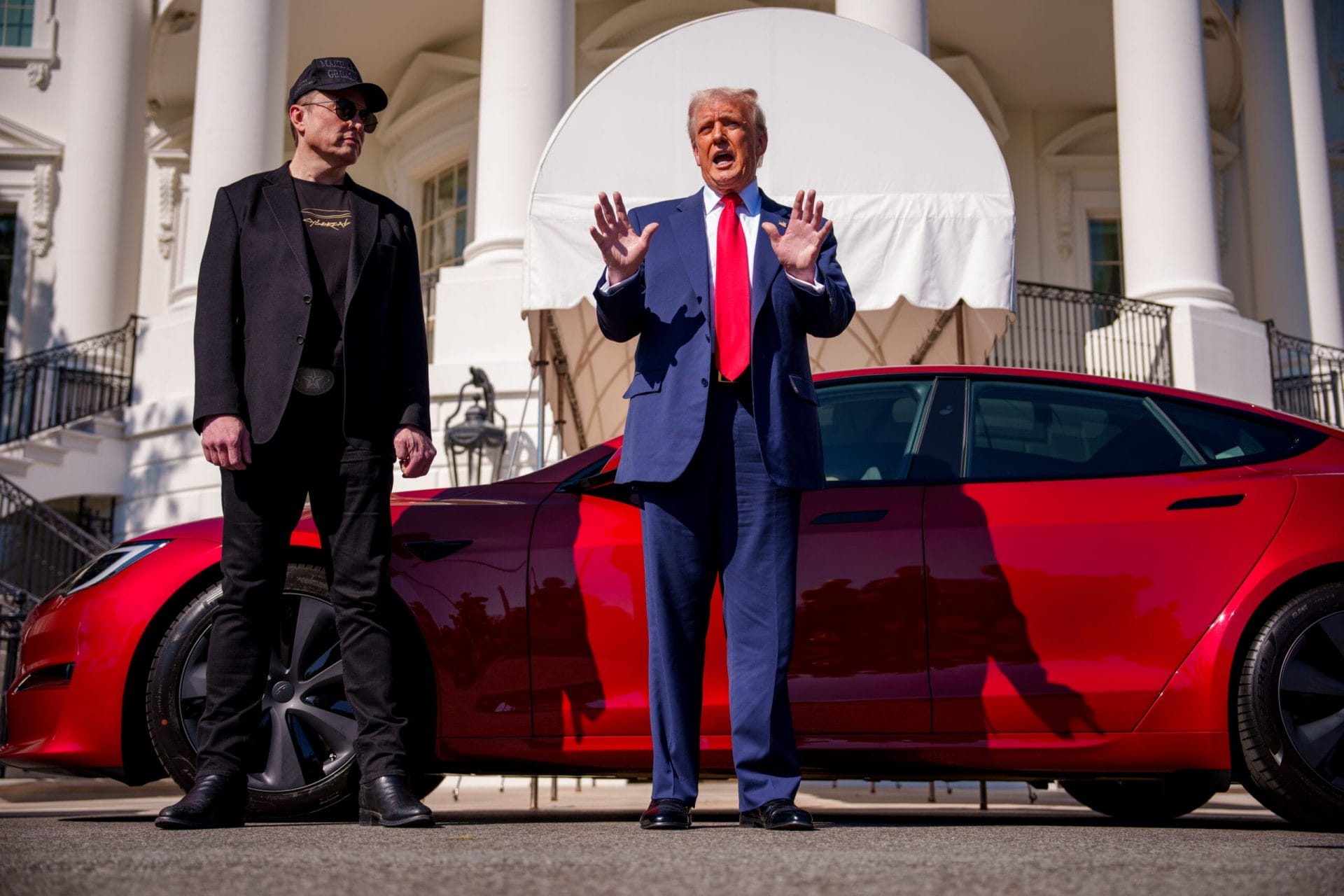
Trump proposed merging the ATF and the DEA.
In an alarming move, Trump is considering merging the Bureau of Alcohol, Tobacco, Firearms and Explosives (ATF) and the Drug Enforcement Agency (DEA). Cutting resources from the ATF—which is what this merger would likely do—would effectively defund the police, weakening efforts to stop gun traffickers, straw purchasers, and gun dealers who are breaking the law.
This move would also limit the power of both agencies, and would represent one of the biggest shakeups of American federal law enforcement agencies since the terrorist attacks on September 11, 2011.
Trump is considering a plan to allow gun rights to be restored to people convicted of domestic abuse.
Source
Susan B. Sorenson and Rebecca A. Schut, “Nonfatal Gun Use in Intimate Partner Violence: A Systematic Review of the Literature,” Trauma, Violence, & Abuse 19, no. 4 (2018): 431–442.
In March, news broke that Trump’s Department of Justice is planning to restore gun rights for people who have been convicted of domestic abuse. It’s considering creating a pathway for violent domestic abusers to regain their firearm access with a weak individual review process—posing a dramatic risk to public safety.
When an abusive partner has a gun, a domestic violence victim is five times more likely to be killed. Every year, more than 700 American women are shot to death by intimate partners. That’s more than one every 12 hours.
Trump deleted the Surgeon General’s advisory that labeled gun violence a public health crisis.
In June 2024, the US Surgeon General issued an advisory declaring gun violence a public health crisis. When the advisory was issued, public health officials applauded the news. After all, the American Medical Association declared gun violence a public health crisis in 2016—this was just the necessary federal acknowledgement required to treat this issue as a public health emergency.
But less than a year later, the Trump administration removed the Surgeon General’s advisory from the Department of Health and Human Services website. By making the lifesaving resources and information from this advisory inaccessible, Trump has chosen—once again—to prioritize gun industry profits over protecting kids and families. GIFFORDS is working to keep lifesaving information available to the public and has made the advisory available for anyone to access.
Trump quietly installed known conspiracy theorist and gun extremist Kash Patel—also the director of the FBI—to oversee the ATF.
Without a public announcement, the Trump administration updated the ATF’s “Leadership” webpage to feature FBI Director Kash Patel as acting director of the ATF. In fact, Patel’s close friends at the fringe organization Gun Owners of America first noted the change.
The administration likely chose to keep this decision under the radar because Patel has no experience fighting crime, preventing mass shootings, or stopping domestic terrorism—making him a terrible leader of the only federal law enforcement agency whose sole mission is to fight violent crime.
But on April 9, it was reported that Patel was removed from his ATF position and replaced with US Army Secretary Daniel Driscoll. Notably, Driscoll also already has an important, full-time job running the US Army. Stopping violent crime at the ATF is not a part-time job, and he will likely face the same issues Patel faced when appointed acting director. This agency deserves full-time leadership and the resources necessary to save lives from gun violence.
Trump nominated—and the Senate confirmed—extremists to critical government positions.
In some of his first moves back in office, Trump nominated Kash Patel to be director of the FBI and Robert F. Kennedy Jr. to be the secretary of the Department of Health and Human Services. Patel is an unprecedented threat to public safety and the integrity of federal law enforcement: He has ties to extreme groups like QAnon and Gun Owners of America, and he has zero experience in public safety. Patel is uniquely unqualified to oversee the FBI, which requires experienced leadership and a commitment to protecting all Americans.
RFK Jr. is similarly unqualified to lead the Department of Health and Human Services. He stated that, despite the facts, he does not believe gun violence is a public health crisis, nor does he believe that researching gun violence is important. He is clearly unfit to protect the health and safety of Americans, and he jeopardizes public safety.
However, in the Republican-controlled Senate, both Patel and RFK Jr. were confirmed to their respective positions.
Trump shut down a school safety board that he created in the wake of the Parkland massacre.
After a shooter murdered 17 people—and injured 17 more—at Marjory Stoneman Douglas High School in 2018, Parkland victims’ families pushed for the creation of a government effort to ensure research on school safety was easy for educators and the public to navigate. In response, the Trump administration created the Federal School Safety Clearinghouse, an interagency effort to share resources and best practices related to school safety. But now, Trump is betraying the Parkland victims’ families and their tireless advocacy. He disbanded this crucial resource, effectively choosing the gun lobby’s will over student safety.
Trump weakened the ATF by immediately reassigning its agents to different departments.
In the first week of his second term, Trump and his administration decided to lend agents from the Bureau of Alcohol, Tobacco, Firearms and Explosives (ATF) to “help carry out deportations.” This decision further weakens an already stretched workforce tasked with protecting Americans by fighting gun crime and completely misses the point: A central cause of immigration driving the border crisis is gun violence, fueled by guns trafficked from the US into Mexico and Latin America.
Trump unofficially shuttered the White House Office of Gun Violence Prevention.
Almost immediately into Trump’s new term, the White House Office of Gun Violence Prevention was removed from the White House webpage. While there was no official announcement of the closure from the administration, it hasn’t operated since Trump took office.
While the office operated, it helped coordinate federal response efforts to mass shootings and community gun violence, worked directly with state and local partners to help reduce gun violence, and helped implement the Bipartisan Safer Communities Act and executive actions on gun safety. The creation of this office by President Biden was a huge win for the gun violence prevention movement, which spent years pushing for federal resources to fight this crisis.
However, it seems that Trump is following through on his promise to get rid of all gun safety measures enacted by Biden.
MEDIA REQUESTS
Our experts can speak to the full spectrum of gun violence prevention issues. Have a question? Email us at media@giffords.org.
Contact
Trump allowed fugitives to buy a gun—and then he purged 500,000 records from the background check system.
The Gun Control Act of 1968 declares that if a would-be gun buyer is legally considered a “fugitive from justice,” a gun dealer can’t sell a gun to that person. For the purposes of this law, the FBI considered anyone with an outstanding warrant to be a fugitive. In 2017, however, under Trump’s direction the FBI drastically narrowed the category of people who are legally barred from purchasing guns by declaring that only people who have crossed state lines to avoid prosecution are fugitives. He then purged 500,000 records from the federal background check system that identified fugitives who had been flagged as prohibited from purchasing guns.
Trump banned bump stocks in the short term so the Supreme Court could ensure they’re legal in the long term.
In 2017, a shooter used assault weapons and bump stocks—which allow a semiautomatic weapon to fire as quickly as an automatic—to carry out the worst mass shooting in modern American history at the Route 91 Harvest festival in Las Vegas. In response, Trump instructed the ATF to ban bump stocks, taking surprise action on gun safety. The ATF then proposed and published a rule categorizing guns with bump stocks as machine guns, making them illegal under federal law.
By doing so, however, he played right into the gun lobby’s hands. Some Republicans were reluctant for Congress to pass a law, despite bipartisan support to do so, because of opposition from far-right groups like Gun Owners for America and because laws are notoriously hard to repeal. Instead, they wanted temporary cover and praise for taking action after a horrific mass shooting without having to take an actual vote on gun legislation. After all, it was only a matter of time—perhaps due to their prodding—that the right-wing Supreme Court would take up and possibly reverse this ATF rule.
In 2024, the Supreme Court did just that—it recklessly undid this lifesaving ban and allowed automatic weapons back into civilian life, a decision that Trump quickly accepted.
Trump couldn’t stand up to the NRA on background checks and age limits.
After the mass shooting in Parkland in 2018, Trump attended a listening session with teachers and students where he promised to take strong action on background checks. In fact, he told a room of lawmakers “You’re scared of the NRA” during a televised meeting as he called for a comprehensive gun safety bill—one that included background checks and raising the age limit to buy assault rifles. Of course, he swiftly walked back his support for the latter after meeting privately with NRA officials.
Democrats took control of the House in 2019 and quickly passed both the Bipartisan Background Checks Act, which would expand federal background checks, and the Enhanced Background Checks Act of 2019, which would close the Charleston Loophole and extend the window for completing a background check from three to 10 days. Instead of following through on his promise, however, Trump threatened to veto these bills if they passed the Senate.
Just months later, Americans watched mass shootings claim the lives of 32 people in El Paso, Texas, and Dayton, Ohio, leaving dozens more injured. Trump once again reversed his position on background checks, calling for strong legislation to address the issue—but offered no details on whether he’d veto similar bills to what had already been proposed.
Trump nominated 234 judges, including three right-wing Supreme Court justices, who have and will continue to shape this country’s judicial system for decades.
The most enduring legacy of Trump’s first—and possibly second—term will be just how many judges he appointed to lifetime positions. We’ve already seen the detrimental impact of these appointees, who have set significant legal precedents on gun and Second Amendment cases as well as many other life-or-death issues.
In fact, in 2022 the Supreme Court’s decision in Bruen, which announced a radical—and illogical—new framework for evaluating Second Amendment challenges, was only possible because of Trump’s picks for the Supreme Court. This decision immediately caused a wave of gun lobby challenges on gun laws nationwide, allowing ideologically driven judges to weaponize Bruen to strike down long-standing gun laws—which was always the plan.
Trump spoke at every single NRA convention while in office, repeatedly assuring the gun lobby that he would prioritize its policy goals.
In 2017, Trump became the first sitting president in more than 30 years to speak at the NRA’s annual convention. To no one’s surprise, he thanked the lobbying group for its $30 million in campaign contributions, saying, “You came through for me, and I am going to come through for you.” In 2018, shortly after he promised to take action on guns in wake of the Parkland shooting, he spoke at its annual convention once again—walking back his promise and declaring that “your Second Amendment rights are under siege, but they will never ever be under siege as long as I am your president.” And in 2019, amidst the infighting amongst leadership of the NRA, Trump called himself a champion of gun rights and used his speech as an opportunity to pull out of an international arms treaty.
Trump tried to make it easier for people to build ghost guns—homemade, untraceable firearms that are increasingly used in crimes.
In 2015, the Obama administration sued the ghost gun company Defense Distributed for publishing its blueprints for 3D-printed guns online. It argued that by doing so, Defense Distributed was facilitating the creation of dangerous ghost guns, which are typically undetectable and untraceable. Both a district and appellate court sided with the administration.
Once Trump was in office, however, Defense Distributed claimed that blocking these publications was a violation of free speech—and Trump abruptly settled the lawsuit and permitted the organization to continue publishing its blueprints. Fortunately, this decision was halted by an injunction after several state attorneys general filed suit against the State Department.
But this wasn’t the end. In January 2020, Trump decided to remove 3D-printed ghost guns and their technical data from the State Department’s weapons list and moved regulation to the Commerce Department. By doing so, he narrowed federal ghost gun guidance and made existing restrictions easy to evade.
Fortunately, the Biden administration took executive action to stem the flow of ghost guns into communities, including having ATF finalize a rule defining weapon parts kits as firearms and therefore making them subject to the same regulations—including serializing the parts and conducting background checks for every sale. This rule has been upheld by the Supreme Court.
TAKE ACTION
The gun safety movement is on the march: Americans from different background are united in standing up for safer schools and communities. Join us to make your voice heard and power our next wave of victories.
GET INVOLVED